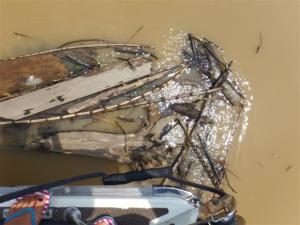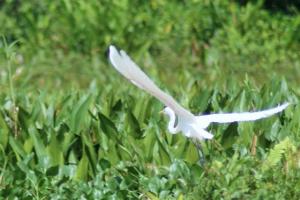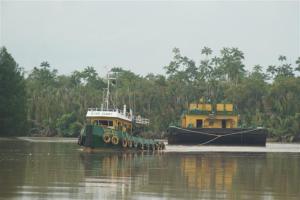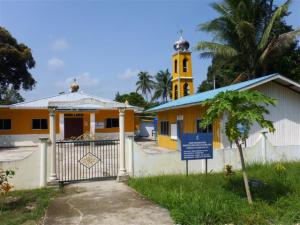Blog Archives
The Kinabatangan River
Posted by yachtcamomile
We spent a week at Sandakan before moving on to the Kinabatangan river. The night before we left a huge storm swept across the anchorage causing some of the boats to drag again. There was so much rubbish on the sea bed the anchors couldn’t dig in properly. The pink area on this chart is rain, when it rains here it rains!! This chart also shows the waypoints and our route plotted across the sandbanks to the entrance to the Kinabatangan river. The entrance has a sandbar and lots of sandbanks, it looks like our route went over the shallows but we didn’t have less than a metre under our keel the whole journey on the high tide.
Our friends on Jackster followed us in and Samsara II were a little way behind them. Fortunately the convoy had broken up a bit, some of the catamarans had gone in a day or two earlier and some of the mono hulls were still in Sandakan waiting another day or two for a higher high tide.
I took up my position on the bow with my deckchair, sunshade and binoculars looking out for wildlife.
The Kinabatangan river is Sabah’s longest at 560km of chocolate brown water, it coils into the Borneo interior. There’s a narrow strip of rain forest trees that have lots of wildlife in it that flee ever-encroaching palm-oil plantations. The scenery was beautiful not in a ‘chocolate box cottage’ kind of way but in a ‘Borneo rainforest’ kind of way.
Our plan was to slowly glide along and just stop whenever we saw something interesting. All along the river are different types of trees holding 100s of monkeys. We were able to get in quite close to the rivers edge; it was fairly deep.
There were Proboscis monkeys everywhere; the males have large pendulus noses. They leap from tree to tree, bush to bush. We have lots of photos of them but here are just a few.
 The three boats anchored together that evening and we all enjoyed a fantastic display of fireflies once it got dark. Our waypoint was
The three boats anchored together that evening and we all enjoyed a fantastic display of fireflies once it got dark. Our waypoint was
05º42.08N
118º21.63E
Waking up in the morning in the middle of a rain forest was magical. The silence was very noisy.
We got under way and continued our slow journey stopping whenever we caught sight of something in the trees.
We went past some homesteads. The little shed on the waters edge is a ‘long drop’ toilet. Then a bit further along the riverbank the ladies were washing their hair and their clothes, as they’ve probably done for centuries, and the children were swimming in the water. The river flowed fairly fast so I suppose everything gets washed out to sea.
These young boys were fishing, not sure I would like to eat anything caught in that water.
Yes this house is sloping towards the water; I wasn’t holding the camera crooked.
We turned right into the main river and anchored off of a resort for the rest of the day. There were lots of lumps of wood floating down the river. The egrets like to stand on them and float down with the tide and watch for fish but they were a real nuisance getting caught around the anchor chain.
There was more heavy rain in the afternoon, well we are in a rainforest. We only travelled about 6 miles that day, if it hadn’t rained we might have gone on but we had plenty of time. Our waypoint was
05º41.10N
118º22.98E
The next morning we made our way to the entrance of an oxbow lake, which was only 3 miles away. An oxbow lake is a U-shaped body of water that forms when a wide meander from the main stem of a river is cut off, creating a freestanding body of water. The first part was long and narrow then it opened up into the lake and wow!
The photos don’t do it justice but I’ve taken some panoramic shots to try and recreate our view.
The bird life was fantastic. Lots of hornbills, egrets and this beautiful kingfisher with an orange breast and red beak.
The blue water hyacinths that covered more than half the lake were exquisite.
Jackster and Samsara were there too.
After an hour or so we motored back to the boats, I took up my position on the bow again and we continued up the river. We were so lucky being the lead boat that day because just around the next bend I saw a pygmy elephant drinking from the river.
It was on it’s own and we glided slowly towards it but it saw us coming and turned back into jungle. The others arrived and we could hear it stamping around behind the bush but it didn’t come back out again.
The pencil marks the spot where we saw the elephant. The red and white flag at the bottom of the chart is as far as we could go because it’s marking power lines that we couldn’t get under.
Our third night at anchor was spent only about an hour before the power lines next to a tributary. We took a closer look in the dinghy. There was webbing stretched high up across the tributary. Just as we were wondering what it was for a couple of monkeys walked along it. When they stopped they wound their tails expertly around the webbing hanging down for balance. We got some great photos of them.
Further in there were lots of macaque monkeys playing in the undergrowth.
A stunning sunset awaited us back at the boat.
Our waypoint was
05º33.35N
118º20.17E
The next day we motored the last hour into Sukau the village next to the power lines.
The waypoint was
05º30.48N
118º17.54E our chartplotter showed this on land but the chart had been roughly correct up to the last little bit.
Our old friend the ‘tug and tow’ was there to greet us. We were only 20 miles inland as the crow flies but we’d travelled 41 miles from the river entrance. I don’t think Camomile has been that far away from the sea since crossing the Panama canal.
I went ashore to explore Sukau. There was the usual mosque and several rows of prettily painted houses with the usual washing hanging out.
The roads were only dirt tracks but to cross the river a barge was used pushed along by a large tug.
I walked for a couple of miles on a circuit from the village to a couple of resorts and back. Sadly I found as soon as I was away from the river the trees changed to palm oil plantations, miles and miles of them. It’s so wrong because the wildlife can’t live in them and in particular the wild Orang-utans need proper trees to live in.
We spent 2 nights in Sukau before making our way back down the river. On the second evening we took the dinghy under the power lines to see what we could find. We found a whole herd of pygmy elephants and we managed to get really close. So lucky
I took 100s of photos and it was difficult choosing which ones to post on my blog, I hope you like my choice. A photo can show you what we saw but you can’t feel the temperature or the humidity, you can’t smell the jungle and you can’t hear the sounds of which there was a cacophony.
Posted in Circumnavigation, Port posts, sailing adventure
Tags: Kinabatangan river, pygmy elephants, Sukau











































